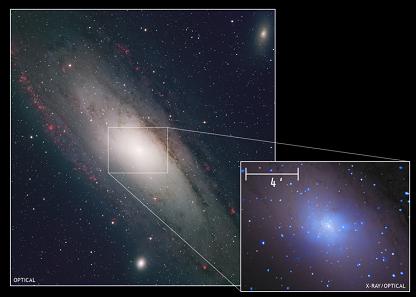Combining photographs from ground-based telescopes, and the Chanadra space telescope, reveals an interesting phenomenon regarding the distribution of many white dwarfs, and sheds light on the fate of these stars

Andromeda, the nearest large galaxy to the Milky Way, is seen in a wide-field optical photograph taken from the Kite Peak Observatory. The center of the galaxy is seen magnified in a composite image, where an X-ray photograph by the Chandra Space Telescope is combined with the optical photograph. Astronomers believe that Andromeda, also known as M31, and the Milky Way will merge within a few billion years.
In the composite image, hot gas, particularly prominent in the X-field, appears to envelop the central region of Andromeda. There are also prominent point sources, most of which are pairs of stars that have material interaction between them. This image shows that these binary stars, which likely contain white dwarfs, are pulling huge amounts of material from the companion star. When these huge amounts of gas reach the white dwarf, thermonuclear explosions occur on the surface of the white dwarf, emitting strong X-ray radiation.
Through many observations of these events, called novae, using the European Space Agency's Chandra and Newton telescopes, a team of astronomers was able to study how long an X-ray burst lasts. They found that some novae luminosities in the X-domain for an incredibly short period of time, and they speculate that they missed these explosions. Such short periods of luminosity in the X-domain, according to the theoretical calculations, indicates that the white dwarfs have a relatively high mass. This makes these white dwarfs good candidates to become a type of supernova known as LA, where the white dwarf reaches the mass limit, undergoes a thermonuclear explosion and is completely destroyed. The large masses that emerge from the calculations of the intensity of the X-ray bursts have led the scientists to hypothesize that the white dwarfs do not accumulate so much mass before they reach the limit and are destroyed. A long-term goal in stellar astrophysics is to identify the elusive stars that explode as LA-type supernovae.
